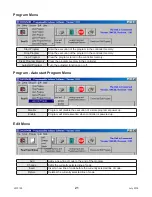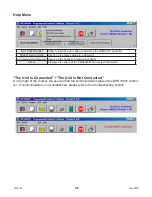
September 2012
L010155
10
Reducing Output Current
Reducing the output current is accomplished by setting switch 1 of the DIP switch to the ON posi-
tion and occurs approximately 1 second after the last positive going edge of the step clock input.
The amount of current per phase in the reduction mode is approximately 70% of the set current.
When the current reduction circuit is activated, the current reduction resistor is paralleled with the
current adjustment potentiometer. This lowers the total resistance value, and thus lowers the per
Phase output current. The purpose of the reducing current is to lower power consumption when
the stepper motor is stopped. The reducing current also helps reduce the internal temperature
of the stepper motor since less current is being driven on the motor windings. With limiting these
factors, the stepper motor lifetime can be lengthened.
Determining Output Current
The output current for the motor used when microstepping is determined differently from that of
a full/half step unipolar driver. In the DPN10601, a sine/cosine output function is used in rotating
the motor. The output current for a given motor is determined by the motors current rating and
the wiring configuration of the motor. There is a current adjustment potentiometer used to set
the output current of the DPN10601. This sets the peak output current of the sine/cosine waves.
The specified motor current (which is the unipolar value) is multiplied by a factor of 1.0, 1.4, or
2.0 depending on the motor configuration (series, half-coil, or parallel).
Step Motor Configurations
Step Motors can be configured as 4, 6, or 8 leads. Each configuration requires different currents.
Refer to the lead configurations and the procedures to determine their output current.
WARNING!
Step motors will not run hot even when configured correctly. Damage may occur to
the motor is higher than specified current is used. Most specified motor currents are maximum
values. Care should be taken to not exceed these ratings.
6 Lead Motors
When configuring a 6 lead motor in a
half-coil configuration
(connected from one end of the
coil to the center tap), multiply the specified per Phase (or unipolar) current rating by 1.4 to de
-
termine the current setting potentiometer value. This configuration will provide more torque at
higher speeds when compared to the series configuration.
When configuring the motor in a
series configuration
(connected from end to end with the cen-
ter tap floating) use the specified per phase (or unipolar) current rating to determine the current
setting potentiometer value.
July 2018











































